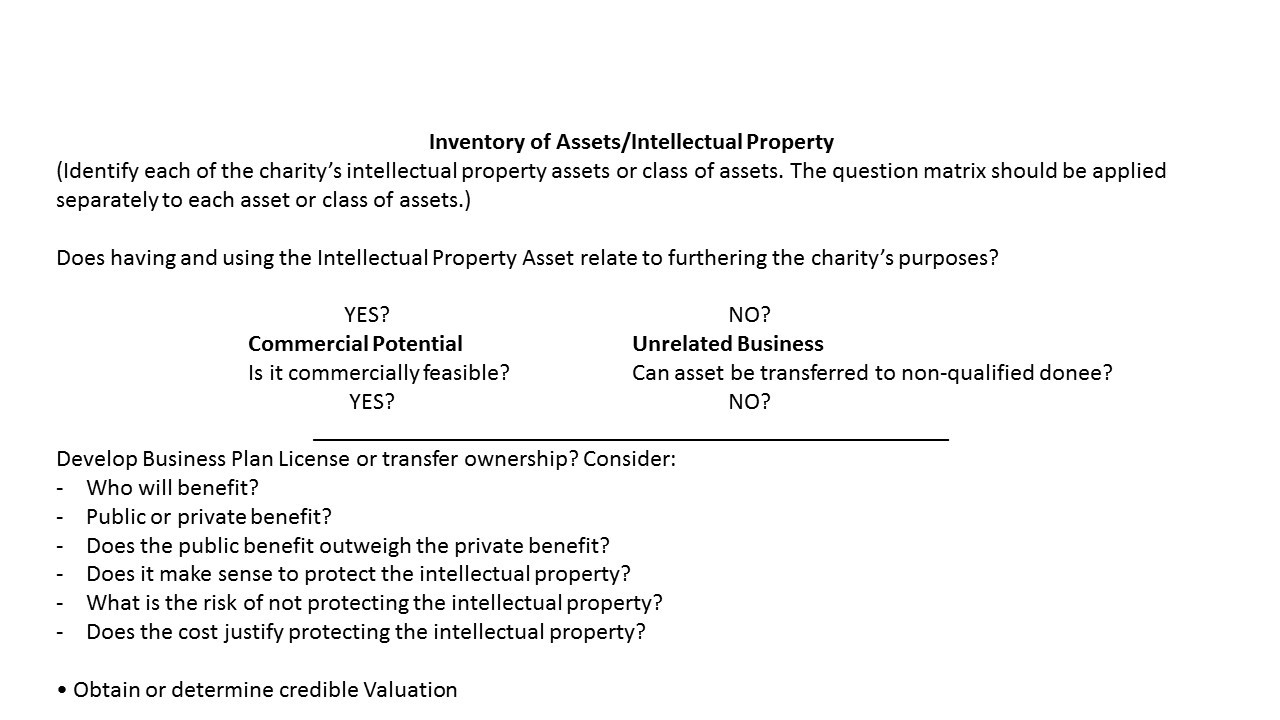- Home
- About Us
- The Team / Contact Us
- Books and Resources
- Privacy Policy
- Nonprofit Employer of Choice Award

 All charities own some form of intellectual property. This intellectual property may be as simple as the charity’s name or logo (usually trademarks) or it may include other major components of the charity’s assets, such as copyrighted material, patents or industrial designs. The IP can be dealt with by the charity itself or through arrangements with spin-off companies or other legally distinct parties.
All charities own some form of intellectual property. This intellectual property may be as simple as the charity’s name or logo (usually trademarks) or it may include other major components of the charity’s assets, such as copyrighted material, patents or industrial designs. The IP can be dealt with by the charity itself or through arrangements with spin-off companies or other legally distinct parties.
Many aspects of IP: developing it, protecting it, using it and disposing of it may raise issues for a charity. Among common regulatory questions around such work are: Is there impermissible private benefit? Is there public dissemination of research related to the IP? Is there is a business being carried on? and, if so, is that business in keeping with the Income Tax Act requirements that apply to charities having businesses?
Leaving aside these specific questions, there is a concern that the rules that apply to charities in this area have not kept up with the realities of using intellectual property in the 21st century.
Themes emerging in discussions for this report included
a) the need for charities to have a greater understanding of intellectual property and how the system works. Many charities are not aware of the value of the assets they own; therefore, they may not be sufficiently protecting these assets whether it’s their names, patents or copyrights.
b) Potential conflicts with a charity’s brand may arise when working with sponsors.
c) Issues with licensing rights to organizations who are not qualified donees.
One common area is brand. The identification of different aspects of a charity’s brand includes corporate, operating and domain names in addition to design logos and slogans. Protecting a charity’s brand can create a number of challenges for a charity including:
• Confusion with respect to similar names being used by other charities
• Intentional misappropriation of the charity brand by third parties
• Disputes between national and provincial branches over a charity’s brand
• Disputes between international and national charities over a charity’s brand
• Failure to enforce trademark rights against offending third parties
• Failure to license trademarks in writing with third parties
• Failure to document sponsorship arrangements in writing
There are a number of steps available to a charity to protect its brand including:
• Registering corporate/business/domain names
• Employing common law remedies
• Registering trademarks
• Overcoming limitations of what are known as section 9 official marks
• Registering foreign trademarks
• Enforcing trademarks
• Licensing trademarks with third parties
• Using a portfolio management approach to maintaining the charity brand
The following matrix of questions was suggested as an evaluation tool:

This area is complex and is increasingly important. Charities would be wise to spend some time considering intellectual property and have a well-thought out view on how much, if at all, they need to do further work in this area.
This is a summary of a few of the ideas in a report done by the Muttart Foundation. The Muttart Foundation considers a robust charitable sector as central to a strong, healthy society. Through their work charities build community and address key social issues and concerns. For a full copy of the report on intellectual property, click here.